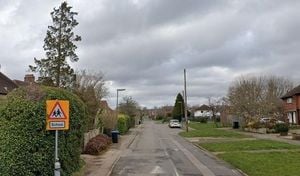As the Thanksgiving holiday approaches, residents and travelers in the Adirondack region and surrounding areas are bracing for a spell of wintry weather that promises to be both dramatic and potentially disruptive. Federal forecasters and local meteorologists alike are sounding the alarm: a combination of colder-than-average temperatures, significant snowfall—particularly at higher elevations—and gusty winds are converging to create what could be one of the most challenging early winter travel periods in recent years.
According to the Climate Prediction Center’s 8–14 Day Outlook, there is a 33–40% chance that the Adirondacks will see above-normal precipitation between November 23 and November 29, 2025. The region sits at the heart of a zone where repeated storm systems are expected to tap into cold Canadian air, setting the stage for accumulating snow in the mountains and a mix of rain and snow in the valleys. Temperatures are forecast to drop sharply across northern New York, increasing the likelihood of wintry conditions just as millions prepare to hit the road for Thanksgiving.
Communities perched in the higher elevations—including Lake Placid, Saranac Lake, Tupper Lake, Old Forge, and the iconic High Peaks—are likely to experience primarily snow, especially from mid to late week. Mountain passes along NY-73, NY-86, and Route 30 could become slick or even snow-covered during and after each passing weather system. Even in the valleys, where precipitation may begin as rain during the day, nighttime cooling could flip things to wet snow, particularly if storm tracks shift southward, as noted by the Climate Prediction Center.
In the eastern Adirondack corridor—stretching from Plattsburgh and Peru to Westport and the Lake Champlain shoreline—precipitation type will vary more. Daytime hours could bring cold rain, but nighttime conditions may turn that rain into a slushy, wet snow, especially in areas where storm centers pass just to the south. Meanwhile, the southern Adirondacks, including Lake George, Warrensburg, and Johnsburg, will see mixed precipitation at lower elevations, with accumulating snow more likely above 1,500 feet.
Behind each weather system, northwest winds are expected to trigger lake-enhanced snow showers, especially on the western slopes of the Adirondacks and in communities downwind of Lake Ontario. These snow showers, though sometimes light, can quickly reduce visibility and create hazardous driving conditions on major routes like I-87 (the Northway), NY-28, NY-30, and the region’s winding mountain roads. Even minor accumulations can make travel treacherous during peak Thanksgiving departure and return periods, a concern echoed by both federal and local authorities.
This week’s conditions are already providing a taste of what’s to come. A Winter Weather Advisory is in effect for Lewis County through 7 PM Monday, November 17, 2025, with snow accumulations of 4 to 7 inches expected in the higher terrain and less than 2 inches in the lower elevations. Winds gusting up to 35 mph will create blowing and drifting snow in open areas, making travel difficult and reducing visibility, according to the National Weather Service.
Just to the south, a Winter Storm Warning remains in effect for Northern Herkimer County and the western Adirondacks until 7 PM Monday. Moderate to heavy snow is forecast, with accumulations between 7 and 14 inches, mainly near and north of Route 28. Roads are likely to become slick and hazardous, with visibilities dropping below a mile at times due to moderate to heavy snowfall and blowing snow. Snowfall rates could reach as much as 0.75 inches per hour at times, making for challenging travel conditions. Officials are urging drivers to be prepared: "If you must travel, keep an extra flashlight, food, and water in your vehicle in case of an emergency," the National Weather Service advised.
Further highlighting the region’s elevation-dependent weather, upslope snow continues to blanket the mountains overnight into Monday, with 1 to 2 feet of snow likely at the summits by Monday evening, according to NBC5 News. Valleys, by contrast, will receive only light accumulations. Even the northern Champlain Valley may see slick travel conditions, with lows dipping into the 20s to around 30°F. Monday will remain cloudy and cold, with a gusty northwest breeze and highs in the mid-30s. Snow showers are expected to diminish on Tuesday, with some afternoon sun and highs in the upper 30s, while Wednesday looks dry, with highs in the low 40s under mostly cloudy skies.
WCAX reports that the First Alert Weather Day will continue into Monday morning, with elevation-dependent snow creating slippery travel in the higher elevations. The heaviest snowfall is expected overnight into early Monday, making commutes especially treacherous in the Adirondacks and on the western-facing slopes of the Green Mountains. Wind gusts over 30 mph will push wind chills into the single digits, increasing the risk of blowing snow and even a few power outages. Snow showers will start to wane Monday night, becoming more scattered overnight. Total accumulation through this period will be highly elevation-dependent: valleys may see only a trace to 2 inches, while higher elevations generally receive 3 to 6 inches, and locally 12 to 18 inches in the Adirondacks and Northern Green Mountains—mainly on northwest-facing slopes near the summits.
As the week progresses, the region can expect a brief respite. Wednesday and Thursday are forecast to bring partly sunny skies, though it will remain chilly for mid-November, with highs mainly in the 30s and lows in the 20s. A new weather system is expected to arrive on Friday, likely bringing a soaking rain rather than snow. Showers and mountain snow showers are in the cards for Saturday, with Sunday shaping up to be dry, according to WCAX.
For now, forecasters emphasize that details about the timing and precise precipitation types for the Thanksgiving week will become clearer as short-range models begin to isolate individual systems approaching the Northeast. But one thing is certain: travelers and residents in the Adirondacks and surrounding areas should stay alert and be prepared for rapidly changing and potentially hazardous winter weather in the days ahead.
With the stakes high for holiday travel and local communities, the coming week will test the region’s readiness for winter—reminding everyone that in the Adirondacks, November can be as unpredictable as it is beautiful.




